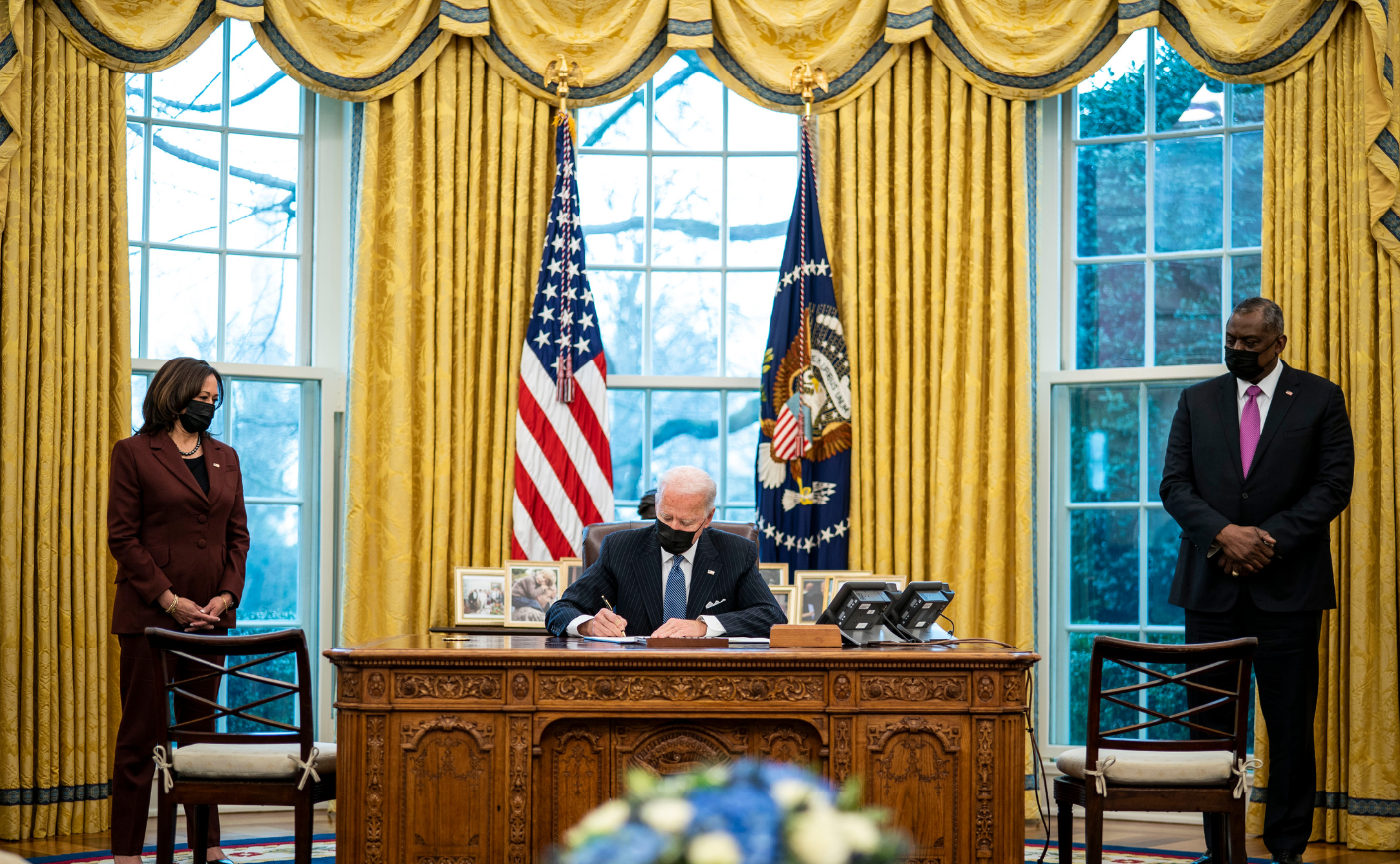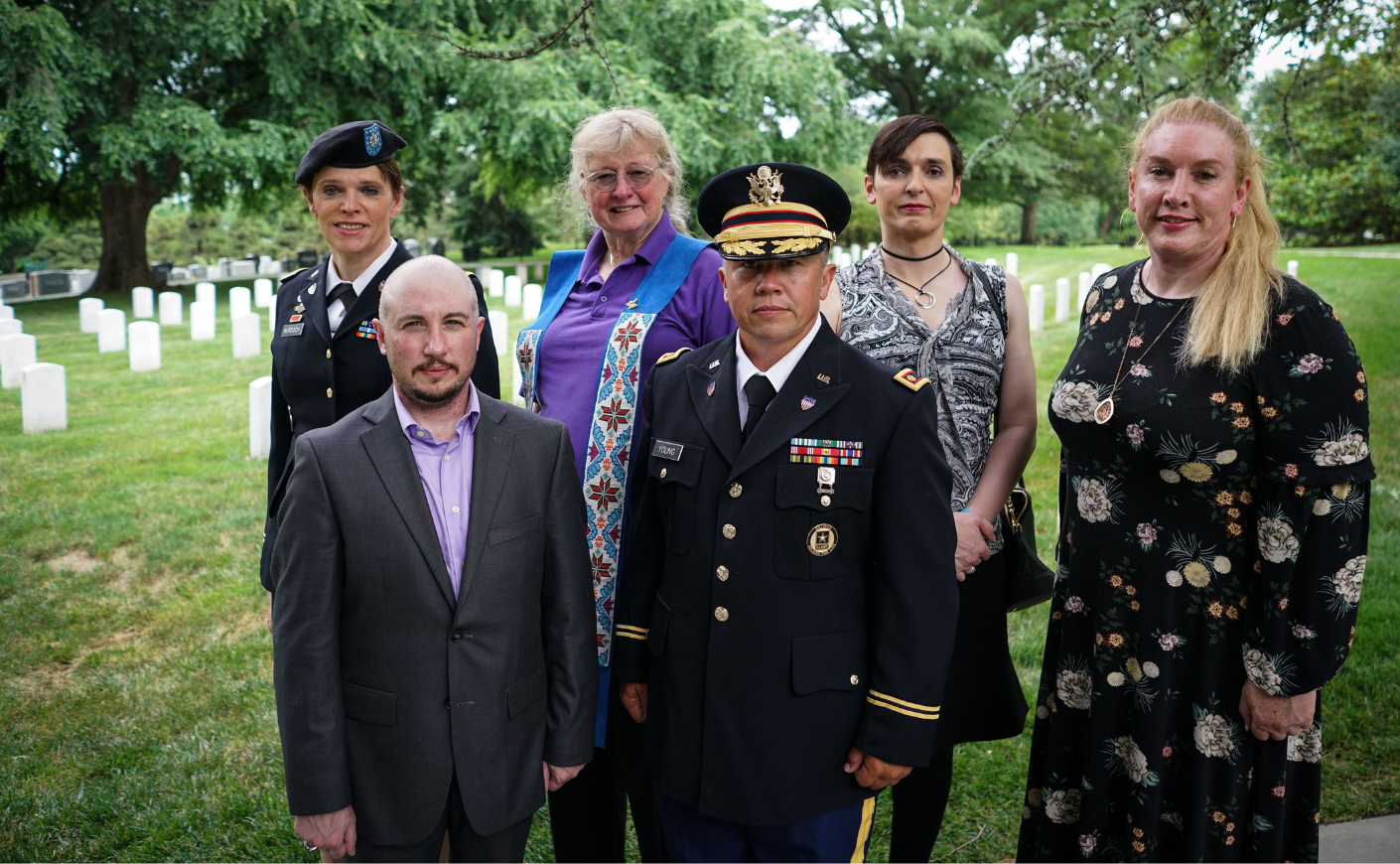As America’s culture wars intensify, the queer community has come under attack: More than 500 anti-LGBTQ bills have been introduced around the country in 2024 alone, and fatal violence is on the rise. Progress that once seemed guaranteed is suddenly in peril, and that precarity could soon affect the transgender men and women who’ve taken an oath to protect the United States.
Trans Americans are currently allowed to serve openly in the military — and receive the healthcare they need to support their transitions — but many conservatives (including Republican presidential nominee Donald Trump) are already indicating that those rights could be stripped, depending on the results of the 2024 election, potentially endangering the livelihood of trans service members around the nation.
One of those members is Air Force Major Julie Clavier, who joined the military in 2012 to work in cyber security and began her gender transition in early 2021. Clavier was one of my closest childhood friends, but we lost touch as we grew into adulthood — so when we recently reconnected, her life looked quite different than when we were kids bonding over Pokémon. To celebrate Pride Month, I called her up to learn more about the trans military experience, the process of transitioning during service, and why the freedom to do so faces an imminent threat.
But before we get into her story, let’s start by outlining how we got here.
What’s the history of the military’s policy for transgender service members?
The LGBTQ experience in the armed forces transformed significantly under President Obama, who in 2011 officially ended the “don’t ask, don’t tell” policy for gays and lesbians that took effect in 1993. But transgender Americans still weren’t allowed to serve openly.
For years, military officials were concerned that the psychological effects of gender dysphoria could render someone incapable of serving to their fullest capacity, even though major professional groups like the American Medical Association and the American Psychiatric Association affirmed that this position was based on outdated science. As Vox explained in 2015, “most medical experts today … agree that hormone therapy and other forms of care can treat those suffering from gender dysphoria. And not all trans people suffer from severe gender dysphoria in the first place.”
As the conversation continued to evolve (including support from then-Vice President Joe Biden, who in 2015 called transgender rights “the civil rights issue of our time”), the Obama administration officially lifted the ban on trans service members in June 2016, marking a monumental victory for LGBTQ rights in America.
For Clavier, this decision prompted introspection about her own gender identity, which she hadn’t yet begun to interrogate seriously, other than having “vague inklings growing up.” She recalls, “I saw that trans people could serve openly, and I was like, That makes me feel good — but wait, why is that?”
Clavier’s questions about her gender became “more present” following the lifting of the ban. She followed news about other trans service members, struggled internally with her own feelings, and eventually broached the topic with her wife. By mid-2020, she was prepared to officially begin transitioning.
But things had changed dramatically by then: After Donald Trump became president in 2017, he tweeted that the federal government would no longer “accept or allow transgender individuals to serve in any capacity in the U.S. military,” undoing the progress that had been made under Obama.
Trump’s posts reportedly “blindsided” military leaders. And although the ban was delayed by legal challenges, the Supreme Court allowed it to go into effect in 2019.
When Joe Biden won the 2020 election, the LGBTQ community anticipated a reversal. That included Clavier, who contacted her therapist after the race was called and asked for her records to be forwarded to her superiors, effectively notifying them of her gender dysphoria diagnosis. That would begin the formal process of obtaining gender-affirming care from the military — even though Trump still hadn’t officially left office.
“There was always the worry of, well, maybe Biden doesn’t [lift the ban], and then I’ve just screwed myself over,” Clavier says. “But I was 99 percent certain it was going to happen, and everybody around me was as well. It was like, ‘You believe it, I believe it, that’s good enough for me.’”
In early 2021, that expectation became reality as Biden officially reversed Trump’s ban, permitting trans Americans to serve openly under their self-identified gender and allowing them access to medical treatment for transitioning.

What kind of healthcare do transgender service members get?
Kicking off a transition in the armed forces requires “a lot of paperwork,” Clavier says. Once she’d been officially diagnosed with gender dysphoria, she spent a week with a military medical team, who built a treatment plan that included details like when she’d begin taking hormones or whether she was interested in having any surgeries. This process allowed her to change her gender marker, which opens a number of doors for self-expression.
“If you’re transitioning to female, that allows you to grow out your hair, wear makeup, wear earrings,” Clavier explains — aesthetic decisions that, under the military’s strict regulations, wouldn’t be acceptable for men.
Once her supervisors signed off on her care plan, Clavier met with her primary doctor to put it into action. The military has provided all the gender-affirming treatment she’s needed, which she says is “pretty much the standard” these days.

That doesn’t necessarily mean that treatment happens in a timely manner, however. Transition-related surgeries are only available at a small handful of military hospitals in the United States, which causes a bottleneck for service members who want to get their care within the military system. Clavier says she knows of someone who took a part-time job at Starbucks — on top of the demanding duties of the military — to qualify for a separate insurance network that includes more doctors who can perform these surgeries.
But for members willing to receive their treatment at a potentially slower pace, the military’s TRICARE system does cover both surgical and non-surgical procedures. The Congressional Research Service estimated that between January 2016 and May 2021, the Department of Defense spent $15 million to provide this care to 1,892 trans service members.
How are transgender military members treated by colleagues?
Although the military supports the transitions of members with a gender dysphoria diagnosis, the organization at large isn’t without discrimination.
A 2019 study published in the journal Stigma and Health, which surveyed 174 transgender service members, found that 93 percent of them had experienced at least one instance of “gender identity-related stigma in the military, including bullying and barriers to obtaining gender-affirming services.”
“Although service members reported generally good health and psychosocial functioning,” the study said, “stigma in the military was significantly associated with poorer overall mental health and greater depression, anxiety, and stress, after adjusting for age, gender identity, race, and service rank.”

Clavier explains that, like any workplace, the Air Force has subgroups with their own individual cultures. To generalize, pilots and mechanics may exemplify the more traditional, hyper-masculine personalities often associated with the armed forces, whereas self-described “nerds,” as Clavier calls people like herself, might work in cyber security.
In characterizing the treatment she’s received since transitioning, Clavier references an old military adage: “Rank has its privileges.” What she means is that, because she was an Air Force member for many years before her transition, she had time to earn the respect of her peers and arrive at a place where she’s mostly liaising with high-ranking officials, who she says are less likely to openly engage in discrimination.
“I’ve never really experienced any transphobia directed at me during my process,” Clavier says. “But that’s not to say it doesn’t exist. I could open our private Facebook page on any day of the week and show you people whose care is being delayed or not approved, because maybe their supervisors don’t agree with it.”
Clavier says she makes a concerted effort to help others whose transition plans haven’t gone as smoothly as her own. She serves as the secretary of a working group devoted to trans issues in the armed forces, has visited Capitol Hill to speak with senators and representatives, and has also been involved with groups like SPARTA, a trans advocacy organization for military members.
Why the 2024 election could put trans service members at risk
While Clavier and many other trans service members have enjoyed freedoms and protections over the last few years, there’s a very real possibility that those could all come to a screeching halt.
“We don’t know what’s going to happen if Trump gets re-elected,” Clavier says. “He’s already stated that he wants to bring back this ban, and we’re predicting that it’s going to be a full ban. So if you’re serving and you’ve had any type of [transitional] surgeries, [you could be discharged].”
Like many others, this prospect gives Clavier significant anxiety. She’s the sole breadwinner of a family that includes her wife and two children, and being forced out of the military and into an uncertain job market is worrisome.
In 2023, California congresswoman Sara Jacobs introduced the Ensuring Military Readiness Not Discrimination Act into the House of Representatives. It’s also known as the “Truman Amendment,” a reference to President Harry Truman’s 1948 executive order that created the Committee on Equality of Treatment and Opportunity in the Armed Services. If passed, the bill would protect against military discrimination on the basis of “race, color, national origin, religion, or sex (including gender identity, sexual orientation, or sex characteristics).”
Clavier says contacting senators and representatives to support this legislation is one of the best ways the average citizen can support trans service members. She also points out that everyone who serves in the armed forces is subject to strict requirements — which say nothing about anyone’s identified sex.
“It really comes down to standards in the military,” she says. “Everybody is expected to meet these standards, and if you can meet them, you should be able to serve, regardless of your gender identity.”









